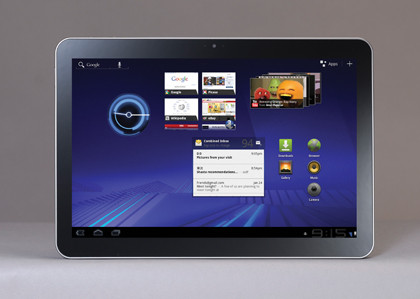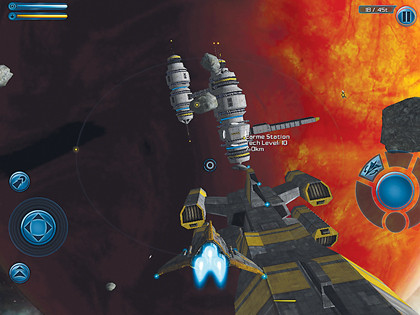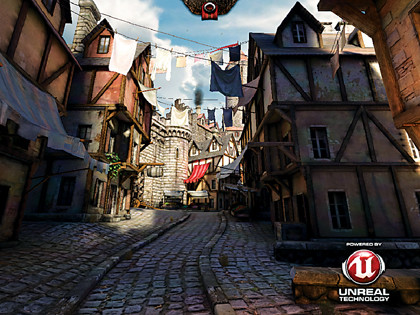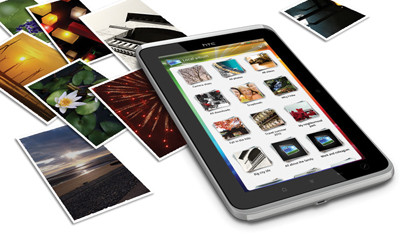Returning to the Nvidia Tegra 2, it uses what's called the ultra-low power (ULP) GeForce GPU. Think DirectX 9 and a card with four pixel shaders and four vertex shader cores. It's capable of 5x Coverage Sample Anti-aliasing (CSAA) and 16x anisotropic filtering. Running at 300MHz and with each core executing two FLOPS per clock, that's a peak output of 4.8GFLOPS. But because these aren't unified shaders, it would take careful optimisation to get the best out of them.
Remember PowerVR? That's the de facto standard in the mobile world. Its tiled-based deferred rendering in a power-limited environment has delivered better performance per watt than Z-buffer alternatives.

The current range in almost all SoC solutions is the PowerVR SGX5xx series. Usually running at 200MHz, all the models use a Universal Scalable Shader Engine (USSE). It's able to perform geometry, pixel and GP-GPU operations. Each pipeline is highly flexible and able to complete two FLOPS per clock, with the latest generation of USSE2 cores issuing twice as many instructions, increasing that to four FLOPS per clock.
The PowerVR SGX535 in the Apple A4 and Intel Atom has a pair of USSEs able to run two FLOPS at 200MHz for a maximum 1.6GFLOPS. The Galaxy S has a PowerVR SGX540, offering four USSEs for a maximum 3.2GFLOPS.
That's no problem for the Nvidia Tegra 2, until you hit the latest generation of multi-core PowerVR SGX54x models. The iPad 2 makes use of a dual-core SGX543MP2 with a total of eight USSE2 units, each capable of four FLOPS for an impressive 12.8GFLOPS.
The PS Vita will have a quad version of this running at 543MHz, with the technology scaling up to 16 cores. Nvidia has the Tegra 2 running Quake 97 per cent faster than the Galaxy S, but it should do - the Galaxy S is a 1GHz single-core ARM Cortex-A8 using the 3.2GFLOPs PowerVR SGX540. A Tegra 2 running a single core runs 62 per cent slower, never mind if it also has a third less graphical power.
Against the iPad 2, the Tegra 2-powered Motorola Xoom performs at about a third of the speed. At best, it gives two thirds of the performance. But direct comparison is tricky due to resolution and OS differences.
Sign up for breaking news, reviews, opinion, top tech deals, and more.
Tablet games
Specific 3D performance hasn't been something tablets have been sold on. Apple gave a nod to it when the iPad 2 was launched, claiming nine-times the graphical performance over the iPad, but Nvidia is trying to drive this home in a real sense. We might finally be seeing an end to the 'Angry Bird period' of mobile gaming.

The company has its Tegra Zone app, which helps promote Tegra-optimised games such as Samurai II: Vengeance THD, Dungeon Defenders and Monster Madness. But beyond this, the tablet gaming scene remains embryonic, with a heavy mix of indie games and a few AAA titles.
Oddly enough, DirectX 9 and DirectX 10 hardware support is here - largely because it's a pre-requisite for Windows Phone 7 devices. It's already available on some PowerVR models, such as the SGX535 and SGX545, but all current mobile games are developed for OpenGL ES 2.0, which is supported by Android and Apple iOS.
A key element in game production is a mature development engine. If you want exciting 3D games then you want developers to have access to the best tools. The good news is that there's certainly not a shortage of free or big-name kit out there.
Due to its popularity, Apple iOS has gained the most attention, but Android is certainly catching up, with development tools supporting both. Cocos2D is a free 2D aid that's spawned a load of games. iTorque is a well-known and long-running environment, is low-cost and offers 2D and 3D kits.
While you may have come across Unity for Flash games, it also provides relatively low-cost 3D development tools. If you're hoping for big-name support, Epic already has the Unreal Engine 3 on Apple iOS. You can try it out with Epic Citadel from the App Store.

While id Software beavers away with RAGE, it's also been developing a mobile id Tech 5 Apple iOS engine that spawned the RAGE HD game. John Carmack, technical director at id, has publicly commented that it plans to create an Android version as well.
Tablet builds
But it's not all about what's inside a tablet. We should step back and take some time admiring the tantalisingly slim exteriors - all the tablets on the market have a slimline build. There's no doubt that the iPad 2 is the most perfectly engineered, but the Asus Eee Pad Transformer is close.
The second thing the iPad and Transformer get spot on is the screen. The former has a less than stellar 1,024 x 768 resolution - good enough, but you can tell that alternatives such as the Galaxy Tab and Asus Transformer, both 1,280 x 800, are sharper and perfect for HD content.
Responsiveness is also vital. All tablets should be capacitive, which means the screen is coated with a conductive material, rather than relying on resistive screens that use pressure to function.
Battery technologies are key too. Li-Ion batteries are relatively expensive, but even they're cheaper than the Li-Polymer alternatives found in the iPad and Asus Transformer. Battery capacity is usually measured in milliamp hours (mAh), but companies have started using a watts per hour (Wh) measure, which is the capacity times the operating voltage.
The iPad has a 25Wh battery, the Asus a 24Wh one and the Acer W500 a 36Wh unit. Obviously, the amount of power offered by the battery is only part of the story. Despite its larger battery, the Acer W500 only manages half the runtime of the other two.
Tablet operating systems
Considering that the majority of tablets sold seem to be running very similar hardware, the OS you choose is a large differential between devices.
At the start of 2011, the choice was limited: Apple iOS, Android 2.x or Windows 7, where iOS easily won because it was designed from the ground up to be a touch-controlled tablet OS. Android 2.x almost worked, but it was engineered for small-screened phones, and doesn't support the app store on larger tablet screens.
Samsung and Dell did good work masking this with the Galaxy and Streak, but the host of knock-off Android devices suffered massively. Of course, Windows 7 supports multi-touch, but it's not designed to be its primary input method, so all tablets struggle in one way or another.
The big win for Windows models is that you can run all of your favourite Windows software. Unfortunately, this tends not to be touch-orientated, which undermines the proposition somewhat.

New for 2011, there's Android 3.0, which is specifically designed for tablets and does an excellent job of catching up with iOS from a feature and functionality perspective. If you're a little sick of Apple's controlling nature and dependence on iTunes, it's going to make an excellent alternative.
BlackBerry will also be entering the market with its all-new PlayBook tablet and Tablet OS. Though it will initially lack the number of apps the other platforms have, the company should create a compelling device.
The tablet world is still very much in flux, but is maturing rapidly. From our perspective, Apple iOS devices are beautiful but are also locked into an Apple/iTunes ecosystem, which we find both distasteful and limiting.
Android tablets offer far more choice and variety, even if that includes cheap and nasty options. The BlackBerry PlayBook is an unknown quantity so far, as dedicated Windows 8 tablets will be come 2012. But with prices going as low as £199, tablets certainly can be fun things to play with.